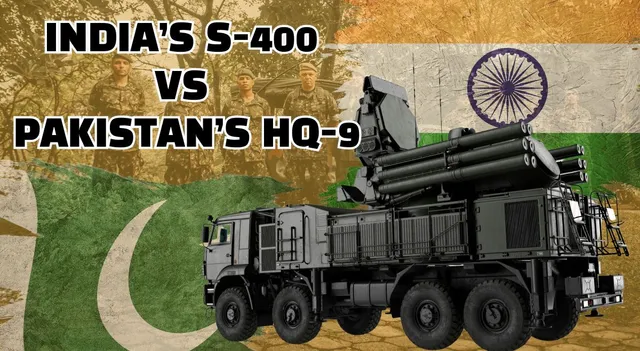- By Ridam Sharma
- Thu, 15 May 2025 06:32 PM (IST)
- Source:JND
India’s Russian S-400 vs Pakistan’s Chinese HQ-9: India acquired one of the most powerful air defence systems, S-400 Triumf, from Russia in 2018, as reported by PIB Delhi. This strategic acquisition was driven by crucial security considerations, including threat perception and operational requirements. On the other hand, Pakistan got hold of HQ-9P through China, which is a customised variant of China’s HQ-9 (Hongqi-9, Red Banner-9), according to IDRW.ORG. Both India's S-400 and Pakistan's HQ-9 are two different generations of air defence systems, indicative of their respective geopolitical locations and strategic features. From their design and their capabilities to battlefield performance, let’s compare S-400 with HQ-9.
Features Of India’s Russian S-400:
India’s Russian S-400 is regarded as one of the world’s most powerful Air Defence Systems, due to all these specifications and features, according to Missile Threat, Centre for Strategic and International Studies.
1. Range: Traces targets up to 600 km and intercepts threats at 250-400 km by employing 48N6E3 ABM from 60 km.
2. Altitude: Engages targets from 10 meters to 30 km altitude.
3. Speed: Neutralises hypersonic threats at up to Mach 14 (approximately 17,000 km/h).
4. Radar: 91N6E "Big Bird" AESA radar and 92N2E Grave Stone radar can track 300+ targets and can engage up to 36 threats at a time with 360-degree surveillance.
5. Mobility: Each of its batteries has 8×8 transporter-erector-launchers (TEL) redeployed.
6. Warhead: 143 kg high-explosive fragmentation (48N6), hit-to-kill (77N6) warhead with proximity fuse.
Features Of Pakistan’s Chinese HQ-9:
Pakistan’s Chinese HQ-9 comprises of following specifications and features, according to the Army Recognition:
1. Range: Base model has 120 km range, extended to 300 km in HQ-9 B.
2. Altitude: Operational up to 30 km.
3. Speed: Can engage targets up to Mach 4.2.
4. Radar: HT-233 phased array can track 100 targets and engage 50 targets simultaneously.
5. Mobility: Chinese Taian TAS-5380 8x8 truck chassis. The TAS-5380 is powered by an air-cooled diesel engine.
6. Warhead: 180 kg high-explosive fragmentation warhead.
S-400 vs HQ-9: Operational Performance
India has obtained a total of five squadrons of the Russian S-400 Triumf air defence missile system, known as Sudarshan Chakra by Indian service. However, out of five, only three squadrons are operational, while the remaining two are expected to be delivered by 2026.
During Operation Sindoor (2025), India's S-400s exhibited formidable strength and even the Prime Minister, Narendra Modi, shared pictures of him saluting with the S-400 air defence system in the backdrop from his Adampur Air Base visit. He also stated in one of his tweets, “brave air warriors and soldiers.”
Sharing some more glimpses from my visit to AFS Adampur. pic.twitter.com/G9NmoAZvTR
— Narendra Modi (@narendramodi) May 13, 2025
Electronic Warfare Capabilities Of S-400 And HQ-9
S-400's L-band radars are jam-resistant via frequency hopping. While HQ-9's C-band HT-233 radar are susceptible to Indian EL/M-2083 jammers.
Which Air Defence System Is Superior -India’s S-400 vs Pakistan’s HQ-9?
The multi-layered interception capability of the S-400 (four missile types with varying ranges) enables India to create overlapping zones of kill up to 400 km deep. This compels competitors to operate from remote bases, cutting sortie rates by 40-60%.
On the other hand, HQ-9's semi-active radar homing is dependent on constant illumination and thus vulnerable to anti-radiation missiles. Pakistan's sparse battery counts, which is estimated 12-18 vs India's 40+ S-400 launchers, leave gaping coverage.
| Parameter | S-400 (India) | HQ-9 (Pakistan) |
|---|---|---|
| Max Engagement Range | 400 km | 300 km |
| Target Speed | Mach 14 | Mach 4.2 |
| Reaction Time | 5 minutes | 30+ minutes |
| Simultaneous Engagements | 80+ targets | 50 targets |
| Radar Detection | 600 km | 120 km |
The Russian S-400 stands out as a more advanced and capable air defence system than the Chinese HQ-9. With its longer detection and engagement ranges, more advanced radar system, and multi-levelled missile offerings, the S-400 provides enhanced protection against a broad range of airborne threats. The HQ-9, though effective, relies on outdated technology and possesses significant range, versatility, and resistance to electronic warfare limitations. Overall, the S-400’s technological sophistication and operational flexibility make it superior in modern integrated air defence solutions.
Read Also: Top 10 Most Powerful People In The World: Is Narendra Modi In The List?

